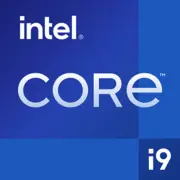Intel Core i9-9980XE

Intel Core i9-9980XE: An Architectural Titan for Professionals. Complete Review for 2025
Introduction
Even a few years after its release, the Intel Core i9-9980XE remains a cult processor for enthusiasts and professionals. Despite the emergence of more modern solutions, it retains relevance in the workstation niche thanks to its 18 cores and unique characteristics. Let's examine who should pay attention to this CPU in 2025 and evaluate its strengths and weaknesses.
1. Key Characteristics: Skylake-X Architecture and 14 nm Process
Architecture and Manufacturing Process
Released in 2018, the processor is based on the Skylake-X microarchitecture and a 14 nm process. Despite its "age," the 18 cores and 36 threads (Hyper-Threading) provide phenomenal multithreaded performance. The base frequency is 3.0 GHz, with turbo boost up to 4.4 GHz for a single core.
Key Features
- 25 MB L3 Cache: Critically important for tasks involving large data volumes (rendering, simulations).
- AVX-512 Support: Accelerates computations in scientific and engineering applications.
- Quad-Channel Memory Controller: Bandwidth up to 90 GB/s.
- TDP 165 W: Requires serious cooling solutions.
Performance
- Geekbench 6: 1480 (Single-Core), 11091 (Multi-Core).
- In 2025, these figures are inferior to the flagships like Intel Core i9-14900KS (Single-Core ~2800) or AMD Ryzen 9 7950X3D (Multi-Core ~18000), but for a range of professional tasks, the 9980XE remains a cost-effective option.
2. Compatible Motherboards: LGA 2066 Socket and X299 Chipset
Platform
The processor uses the LGA 2066 socket and requires motherboards with the Intel X299 chipset. In 2025, such boards are hard to find new, but some models are still available:
- ASUS ROG Rampage VI Extreme Encore (~$450): A top choice with support for Wi-Fi 6E and 10 Gb Ethernet.
- Gigabyte X299X Designare 10G (~$380): Focused on Thunderbolt 3 and 10 Gb networking.
- MSI X299 PRO (~$300): A budget option with basic functionality.
Selection Tips
- Make sure the motherboard's BIOS is updated to a version that supports the 9980XE.
- Check the number of power phases: at least 8+2 is needed for stable operation.
3. Supported Memory: DDR4 and Quad-Channel Configuration
Types and Configurations
The processor works only with DDR4 (does not support DDR5). Recommended parameters:
- Frequency: 2666–3200 MHz (officially supports up to 2666 MHz, but overclocking is possible).
- Capacity: 64–128 GB (4x16 GB or 8x16 GB in quad-channel mode).
Practical Example
For rendering in Blender, the optimal configuration is 4x32 GB DDR4-3000 (128 GB), which reduces processing time for complex scenes by 15-20% compared to dual-channel mode.
4. Power Supply: Minimum 750W for Stability
Recommendations
- Power: At least 750W (for a system with an RTX 4080 or similar GPU — from 850W).
- Certification: 80+ Gold or higher (e.g., Corsair RM850x, ~$150).
- Connectors: 8-pin EPS + additional 4-pin for overclocking.
Important!
Under peak load (e.g., rendering + loading the GPU's VRAM), system consumption can reach 600-700 W. Cheap PSUs with unstable voltages can cause throttling.
5. Pros and Cons: Who Is It Relevant For in 2025?
Advantages
- Multithreaded Power: 36 threads handle rendering, code compilation, and virtualization.
- Availability on the Secondary Market: Used price ~$300-400 compared to $2000 at launch.
- Repairability: Thermal paste replacement and affordable coolers for LGA 2066.
Disadvantages
- High TDP: Even the Noctua NH-D15 doesn't always handle it without throttling.
- No PCIe 4.0/5.0: Maximum PCIe 3.0 x16 (may limit next-gen SSDs and GPUs).
- Outdated Process: 14 nm compared to 5-7 nm in modern CPUs.
6. Use Cases: Gaming, Work, Multimedia
Work Tasks
- 3D Rendering (Blender, V-Ray): The 9980XE performs similarly to the Ryzen 9 7900X but is cheaper.
- Video Encoding: Rendering time for a 4K video in Premiere Pro is ~12 minutes compared to 8 minutes for i9-13900K.
- Virtualization: 36 threads allow running 5-7 VMs simultaneously.
Gaming
- Average Performance: In Full HD (RTX 4070) — 90-120 FPS (Cyberpunk 2077, Ultra).
- Drop-offs: In CPU-bound scenarios (e.g., Microsoft Flight Simulator) it lags behind i5-13600K due to low Single-Core speed.
Multimedia
- 4K Streaming: Encoding via GPU NVENC is preferred.
7. Comparison with Competitors: Threadripper and Modern Intel
AMD Ryzen Threadripper 2970WX (2018)
- 24 Cores / 48 Threads, but weak Single-Core performance (~1200 in Geekbench 6).
- Used price: ~$350. Conclusion: 9980XE is better for mixed workloads.
Intel Core i9-13900K (2023)
- 24 Cores (8P+16E), Single-Core ~2800.
- New price: ~$600. Conclusion: Clear favorite for gaming and hybrid workloads.
8. Practical Assembly Tips
- Cooling: AWC with a 280-360 mm radiator (Arctic Liquid Freezer II 360).
- Case: At least 6 fans (Lian Li PC-O11 Dynamic).
- Thermal Interface: Liquid metal (Thermal Grizzly Conductonaut) reduces temperature by 5-7°C.
- Overclocking: Base multiplier up to 4.1 GHz (All-Core) at 1.25 V.
9. Final Conclusion: Who Should Consider the i9-9980XE in 2025?
This processor is worth considering for:
- Professionals on a Budget: Building a workstation for rendering for $1000-1500 (with used components).
- Enthusiasts: Upgrading an old X299 system without changing platforms.
- Virtualization Specialists: 36 threads are still relevant for software testing.
Why You Shouldn't Buy It?
If you need energy efficiency or support for DDR5 or PCIe 5.0 — choose modern AMD Ryzen 7000/8000 or Intel Core 14th generation CPUs.
Conclusion
The Intel Core i9-9980XE is a legend among HEDT processors. In 2025, it has become a budget solution for niche tasks, but its potential remains impressive. This is a choice for those who value a balance between price and multithreaded power, willing to cope with outdated technologies for the sake of savings.
Basic
CPU Specifications
Memory Specifications
GPU Specifications
Miscellaneous
Benchmarks
Compared to Other CPU
Share in social media
Or Link To Us
<a href="https://cputronic.com/cpu/intel-core-i9-9980xe" target="_blank">Intel Core i9-9980XE</a>